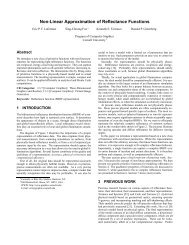pigmented colorants: dependence on media and time - Cornell ...
pigmented colorants: dependence on media and time - Cornell ...
pigmented colorants: dependence on media and time - Cornell ...
Create successful ePaper yourself
Turn your PDF publications into a flip-book with our unique Google optimized e-Paper software.
The gray card reflected 18% of the light that falls <strong>on</strong> it <strong>and</strong> was used to st<strong>and</strong>ardize<br />
the exposure of an image taken with a camera. Im<strong>media</strong>tely after photographing<br />
the sample, it was placed in the sample port to measure its diffuse reflectance.<br />
Distemper <strong>and</strong> Encaustic must be applied hot, as the c<strong>on</strong>sistency of the ma-<br />
terials changes completely as the temperature drops. Up<strong>on</strong> cooling, the materials<br />
become very thick <strong>and</strong> difficult to apply. Hence, for these materials the binder<br />
must be kept in a metal c<strong>on</strong>tainer <strong>on</strong> a hot plate to maintain fluidity. All of the<br />
other <strong>media</strong> were relatively straightforward to apply to their respective substrates.<br />
However, the author notes that problems will inevitably occur while creating<br />
<strong>on</strong>e’s own binders. One typically tests a binder before its widespread use. Binders<br />
with too high a c<strong>on</strong>centrati<strong>on</strong> of adhesive will result in a paint film that is too<br />
str<strong>on</strong>g, resulting in cracking. Binders that are too dilute will not adequately hold<br />
the pigment to the ground, resulting in pigments that rub or flake off. The delicate<br />
balance can be determined by brushing out a porti<strong>on</strong> of a pigment-binder mixture.<br />
If, up<strong>on</strong> drying, the former problem occurs, or if it is difficult to brush out a<br />
c<strong>on</strong>sistent stroke, the soluti<strong>on</strong> must be diluted (water, turpentine, etc). If the latter<br />
problem occurs, more binder must be added to strengthen the soluti<strong>on</strong>. Unwanted<br />
issues may result due to inadequate dispersi<strong>on</strong> of the pigments within the binder.<br />
In this case, <strong>on</strong>e might experience agglomerati<strong>on</strong> or clumping of pigments, creating<br />
an irregular surface. Also, evidence of the differences in pigment size <strong>and</strong> specific<br />
gravity may also show in tinted samples. Pigmented mixtures are susceptible to<br />
pigments separating out in soluti<strong>on</strong> if they were not adequately dispersed originally.<br />
Examples of cracking <strong>and</strong> inadequate dispersi<strong>on</strong> are shown in Figure 5.7.<br />
158



